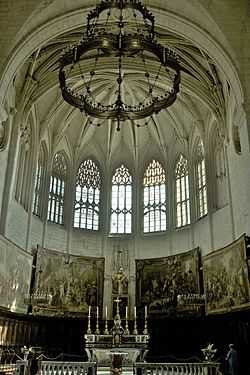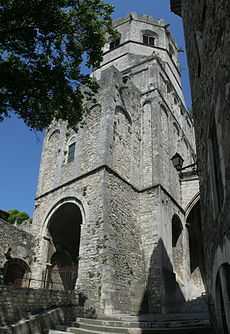Roman Catholic Diocese of Viviers
| Diocese of Viviers Dioecesis Vivariensis Diocèse de Viviers | |
|---|---|
|
| |
| Location | |
| Country | France |
| Ecclesiastical province | Lyon |
| Metropolitan | Archdiocese of Lyon |
| Statistics | |
| Area | 5,556 km2 (2,145 sq mi) |
| Population - Total - Catholics |
(as of 2010) 316,221 281,220 (88.9%) |
| Information | |
| Denomination | Roman Catholic |
| Rite | Roman Rite |
| Established | 4th Century |
| Cathedral | Cathedral of St Vincent in Viviers, Ardèche |
| Patron saint | Saint Vincent |
| Current leadership | |
| Pope | Francis |
| Bishop | François Blondel |
| Metropolitan Archbishop | Cardinal Philippe Barbarin |
| Website | |
| Website of the Diocese | |
The Roman Catholic Diocese of Viviers is a diocese of the Latin Rite of the Roman Catholic church in France. Erected in the 4th century, the diocese was restored in the Concordat of 1822, and comprises the department of Ardèche, in the Region of Rhône-Alpes. Currently the diocese is a suffragan of the Archdiocese of Lyon. Its current bishop is François Marie Joseph Pascal Louis Blondel, appointed in 1999.

History
Saint Andéol, disciple of Saint Polycarp, evangelized the Vivarais under Emperor Septimius Severus and was martyred in 208.
The "Old Charter", drawn up in 950 by Bishop Thomas, the most complete document concerning the primitive Church of Viviers, mentions five bishops who lived at Alba Augusta (modern Alba-la-Romaine): Saint Januarius, Saint Septimus, Saint Maspicianus, Saint Melanius and Saint Avolus. The last was a victim of the invasion of the barbarian Chrocus (the exact date of which is unknown).
In consequence of the ravages suffered by Alba Augusta, the new bishop, Saint Auxonius, transferred the see to Viviers about 430. Promotus was probably the first Bishop of Viviers; the document also mentions later several canonized bishops: Saints Lucian and Valerius (fifth and sixth centuries); Saint Venantius, disciple of Saint Avitus, who was present at the councils held in 517 and 535; Saint Melanius II (sixth century); Saint Eucherius, Saint Firminus, Saint Aulus, Saint Eumachius, Saint Longinus (seventh century); St. Arcontius, martyr (date unknown, perhaps later than the ninth century.
It seems that the Diocese of Viviers was disputed for a long time by the metropolitan Sees of Vienne and Arles. From the eleventh century its dependence on Vienne was not contested. John II, cardinal and Bishop of Viviers (1073–95), had the abbatial church of Cruas consecrated by Urban II and accompanied him to the Council of Clermont.
Afterwards, it is said that Conrad III gave Lower Vivaraisas an independent suzerainty to Bishop William (1147). In the thirteenth century, under the reign of St. Louis of France, the Bishop of Viviers was obliged to recognize the jurisdiction of the Seneschal of Beucaire. By the treaty of 10 July 1305 Philip IV of France obliged the bishops of Viviers to admit the suzerainty of the kings of France over all their temporal domain.
Viviers was often troubled by religious conflicts: the Albigensian Crusade in the thirteenth century; the revolt of the Calvinists against Louis XIII (1627–1629), which ended in the capture of Privas by the royal army; the Dragonnades under Louis XIV after the revocation of the Edict of Nantes; the war of the Camisards.
It was suppressed by the Concordat of 1802, and united to the See of Mende. Re-established in 1822, the diocese then included almost all the ancient Diocese of Viviers and some part of the ancient Diocese of Valence, Vienne, Le Puy and Uzès (see Nîmes) and was suffragan of the Archdiocese of Avignon.
Bishops
To 1000
- Januarius
- Septimius
- Maspicianus
- Melanius I
- c.407-c.411: Avolus
- c.411-c.431: Auxonius
- c.452-c.463: Eulalius
- c.486-c.500: Lucianus
- c.507: Valerius
- c.517-c.537: Venantius
- Rusticus
- c.549: Melanius II.
- Eucherius
- Firminus
- Aulus
- Eumachius
- c.673: Longin
- Johannes I.
- Ardulfus
- c.740: Arconce
- Eribald
- c.815: Thomas I.
- c.833: Tengrin
- c.850: Celse
- c.851: Bernoin
- c.875: Etherius
- c.892: Rostaing I.
- c.908: Richard
- c.950: Thomas II.
- c.965-c.970: Rostaing II.
- c.974: Arman I.
- c.993: Pierre
From 1000 to 1300
- 1014-1041: Arman II.
- 1042-1070: Gérard
- 1073-1095: Johannes II.
- 1096-1119: Leodegarius
- 1119-1124: Atton
- 1125-1131: Pierre I
- 1133-1146: Josserand de Montaigu
- 1147-1155: Guillaume I
- 1157-1170: Raymond d'Uzès
- 1171-1173: Robert de La Tour du Pin
- 1174-1206: Nicolas
- 1206-1220: Burnon
- 1220-1222: Guillaume II.
- 1222-1242: Bermond d'Anduze
- 1244-1254: Arnaud de Vogüé
- 1255-1263: Aimon de Genève
- 1263-1291: Hugues de La Tour du Pin
- 1292-1296: Guillaume de Falguières
- 1297-1306: Aldebert de Peyre
From 1300 to 1500
- 1306-1318: Louis de Poitiers
- 1319-1322: Guillaume de Flavacourt
- 1322-1325: Pierre de Mortemart
- 1325-1326: Pierre de Moussy
- 1326-1330: Aymar de La Voulte
- 1331-1336: Henri de Thoire-Villars
- 1336-1365: Aymar de La Voulte (again)
- 1365-1373: Bertrand de Châteauneuf
- 1373-1375: Pierre de Sarcenas
- 1376-1383: Bernard d'Aigrefeuille
- 1383-1385: Jean Allarmet de Brogny
- 1385-1386: Olivier de Poitiers
- 1387-1388: Pile del Prato
- 1389-1406: Guillaume de Poitiers
- 1406-1442: Jean de Linières
- 1442-1454: Guillaume-Olivier de Poitiers
- 1454-1477: Hélie de Pompadour
- 1477-1478: Giuliano della Rovere
- 1478-1497: Jean de Montchenu
- 1498-1542: Claude de Tournon
From 1500 to 1805
- 1542-1550: Charles Ier de Tournon
- 1551-1554: Simon de Maillé-Brézé
- 1554-1560: Jacques-Marie Sala
- 1560-1565: Alessandro Farnese der Jüngere
- 1565-1571: Eucher de Saint-Vital
- 1571-1572: Pierre V. d'Urre
- 1573-1621: Jean V. de L'Hôtel
- 1621-1690: Louis-François de la Baume de Suze
- 1690-1713: Antoine de La Garde de Chambonas
- 1713-1723: Martin de Ratabon
- 1723: Etienne-Joseph I. de La Fare-Monclar
- 1723-1748: François-Renaud de Villeneuve
- 1748-1778: Joseph-Robin Morel de Mons
- 1778-1802: Charles de La Font de Savine
From 1802
- Vacancy to 1823
- 1823-1825: André Molin
- 1825-1841: Abbon-Pierre-François Bonnel de la Brageresse
- 1841-1857: Joseph Hippolyte Guibert
- 1857-1876: Louis Delcusy
- 1876-1923: Joseph-Michel-Frédéric Bonnet
- 1923-1930: Etienne-Joseph Hurault
- 1931-1937: Pierre-Marie Durieux
- 1937-1965: Alfred Couderc
- 1965-1992: Jean VI. Hermil
- 1992-1998: Jean-Marie Louis Bonfils
- 1999–present: François Marie Joseph Pascal Louis Blondel
